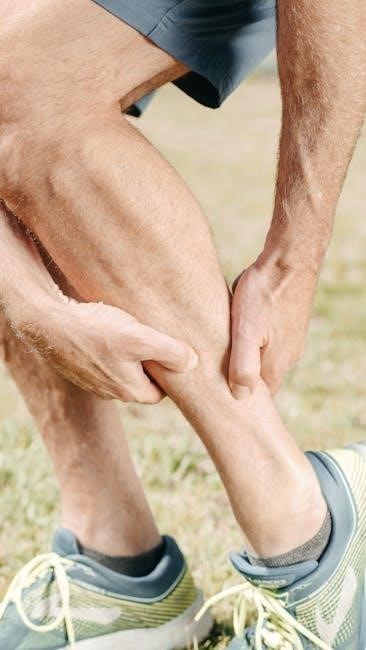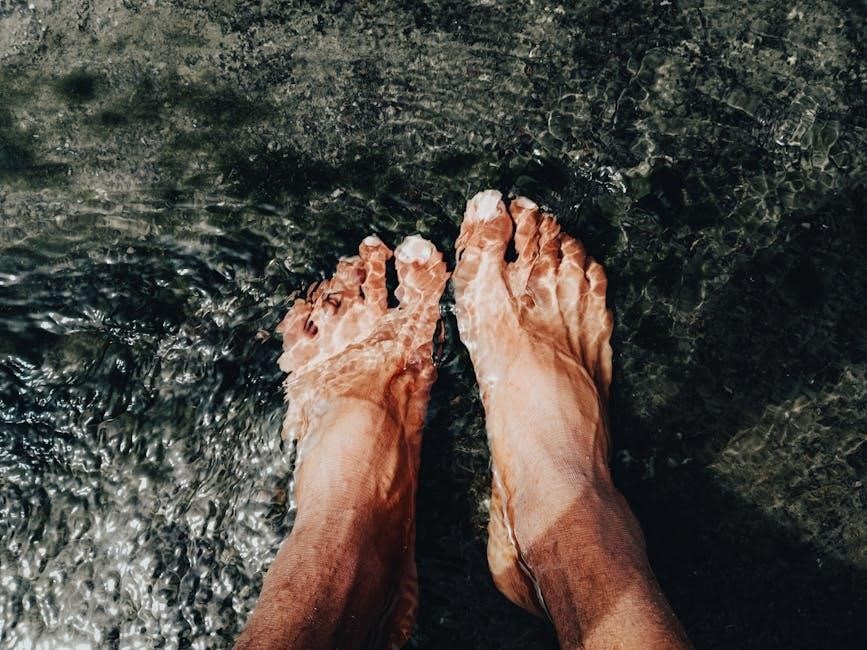Shin splints, or medial tibial stress syndrome, cause pain in the lower leg along the tibia, common in runners and athletes, impacting physical activities.

Causes and Risk Factors
Shin splints, or medial tibial stress syndrome, are often caused by overuse or repetitive stress on the lower leg muscles and tissues. This condition frequently occurs in runners, dancers, and athletes who engage in high-impact activities. Poor footwear, training on hard surfaces, or sudden changes in exercise intensity can exacerbate the risk. Additionally, biomechanical issues, such as flat feet or abnormal gait patterns, can contribute to shin splints. Muscle imbalances, including tight calf muscles or weak core and hip muscles, may also play a role. Overstretching or improper stretching techniques can sometimes worsen the condition. Understanding these factors is crucial for developing effective prevention and treatment strategies.

Symptoms and Diagnosis
Shin splints are characterized by pain along the inner edge of the tibia, often described as a dull ache or sharp discomfort. This pain typically worsens during or after physical activity, such as running or jumping. Swelling and tenderness in the lower leg may also occur. In severe cases, the pain can become debilitating, making it difficult to perform even simple movements. Diagnosis typically involves a physical exam to assess pain locations and tenderness. Imaging tests, such as X-rays or MRIs, may be used to rule out fractures or stress fractures. Early identification of symptoms is crucial for effective treatment and prevention of further injury. Proper diagnosis ensures that the appropriate stretching and strengthening exercises can be implemented to alleviate discomfort and restore mobility.

Importance of Stretching
Stretching plays a vital role in managing and preventing shin splints by improving flexibility, reducing muscle tension, and enhancing blood flow to the lower leg. Tight calf, hamstring, and shin muscles often contribute to the development of shin splints, making regular stretching essential. By targeting these areas, stretching helps alleviate discomfort, reduces the risk of injury, and promotes faster recovery. Incorporating a consistent stretching routine can also enhance athletic performance by improving range of motion and reducing muscle fatigue. Additionally, stretching strengthens the connective tissues around the tibia, providing better support and reducing stress on the shinbone. Over time, this can significantly lower the likelihood of experiencing shin splint pain during physical activities. Thus, stretching is not only a preventive measure but also a key component of effective shin splint management.

Types of Stretches
Several stretches target the lower leg muscles to relieve shin splint pain, including calf stretches, hamstring stretches, hip flexor stretches, Achilles tendon stretches, and shin-specific stretches.
5.1 Calf Stretches
Calf stretches are essential for relieving shin splint pain and improving flexibility in the lower leg. Standing gastrocnemius stretches involve facing a wall with one hand, stepping one leg back, and leaning forward to feel the stretch in the calf. Hold for 15-30 seconds and repeat 3 times on each leg.
Another effective stretch is the seated shin stretch. Sit with your legs extended, loop a towel or resistance band around the ball of your foot, and gently pull your toes toward your head. This targets the tibialis anterior muscle, holding for up to 30 seconds per leg.
Calf raises are also beneficial. Stand on the edge of a stair or step with heels hanging off, raise up onto your toes, then lower slowly. This strengthens the calf muscles and reduces strain on the shinbone. Perform 3 sets of 10-15 repetitions daily.
These stretches help relieve tension, improve circulation, and prevent shin splint flare-ups, making them a key part of any recovery or prevention routine.
5.2 Hamstring Stretches
Hamstring stretches are crucial for addressing shin splints, as tight hamstrings can contribute to poor lower leg mechanics. A standing hamstring stretch involves placing your feet shoulder-width apart, bending forward at the hips, and reaching toward your toes. Hold for 20-30 seconds and repeat 3 times.
Seated hamstring stretches are another effective option. Sit on the floor with your legs extended straight, loop a towel or resistance band around the ball of one foot, and gently pull your toes toward your head. Hold for 15-30 seconds per leg, repeating 3 times on each side.
Lying hamstring stretches can also be beneficial. Lie on your back, lift one leg toward the ceiling, and press your heel upward while keeping your knee straight. Use a strap or towel if needed to deepen the stretch. Hold for 10-15 seconds and repeat 3 times on each leg.
These stretches improve flexibility, reduce muscle tension, and promote proper alignment, helping to alleviate shin splint discomfort.
5.3 Hip Flexor Stretches
Hip flexor stretches are essential for addressing shin splints, as tight hip flexors can lead to poor running mechanics and increased strain on the lower legs. One effective stretch is the kneeling hip flexor stretch. Start by kneeling on one leg with the other foot in front of you, keeping your torso upright. Gently push your hips forward until you feel a stretch in the front of your hip. Hold for 20-30 seconds and repeat 3 times on each leg.
Another option is the standing hip flexor stretch. Stand with your feet shoulder-width apart, take a large step forward with one leg, and lower your body into a lunge position. Keep your back knee nearly touching the ground and your front thigh parallel to the floor. Lean forward slightly to stretch the front of your hip. Hold for 15-30 seconds and switch legs.
These stretches improve hip flexibility, reduce muscle tension, and promote better alignment, which can help alleviate shin splint discomfort and enhance overall lower leg function.

5.4 Achilles Tendon Stretches
Achilles tendon stretches are crucial for addressing shin splints, as tightness in this area can contribute to lower leg pain. One effective stretch is the standing gastrocnemius stretch. Stand facing a wall with one hand on the wall for balance. Step one foot back about a foot, keeping your heel on the ground and your leg straight. Bend the front knee slightly and lean forward until you feel a stretch in the back of your lower leg and Achilles tendon. Hold for 15-30 seconds and repeat 3 times on each leg.
Another beneficial stretch is the seated Achilles tendon stretch. Sit on the floor with your legs extended straight in front of you; Loop a towel or resistance band around the ball of one foot and gently pull your toes toward your head. You should feel a stretch along the back of your ankle and Achilles tendon. Hold for 20-30 seconds and repeat 3 times on each leg.
Regular Achilles tendon stretching can improve flexibility, reduce tightness, and help prevent shin splint discomfort.
5.5 Shin-Specific Stretches
Shin-specific stretches target the muscles and tendons directly surrounding the tibia, helping to alleviate pain and improve flexibility. One effective stretch is the toe-drag stretch. Stand with your feet shoulder-width apart, then slowly lift your toes off the ground and drag them backward toward your shins, keeping your heels fixed. Repeat this motion 10-15 times to release tension in the front of your shins.
Another beneficial stretch is the seated shin stretch. Sit on the floor with your legs straight out in front of you. Loop a resistance band or towel around the ball of one foot and gently pull your toes toward your head. Hold for 20-30 seconds to stretch the anterior tibialis muscle. Repeat 3 times on each leg.
These stretches can help reduce shin splint discomfort by targeting the specific areas causing pain, promoting recovery and preventing future flare-ups.

When to Stretch
Stretching should be done regularly, including before and after workouts, to relieve and prevent shin splint pain, promoting flexibility and reducing muscle tension in the lower legs.
6.1 Before Workout
Stretching before a workout is essential to prevent shin splint pain and improve flexibility. Begin with a standing gastrocnemius stretch: face a wall, step one leg back, and lean forward, keeping the heel on the ground, until a gentle stretch is felt in the calf. Hold for 15-30 seconds and repeat three times on each leg. Additionally, incorporate resisted ankle dorsiflexion by sitting with one leg straight, looping elastic tubing around the arch, and anchoring it in a doorway. Slowly flex the foot upward, resisting the tension, and hold for 10 seconds before releasing. Repeat 10 times on each side. These exercises target the muscles in the lower leg, reducing tightness and preparing them for physical activity. Consistency in pre-workout stretching can significantly lower the risk of shin splint discomfort and enhance overall performance.
6.2 After Workout
Stretching after a workout is crucial for relieving muscle tension and promoting recovery. Begin with a seated calf stretch: sit on the floor with your legs extended, loop a towel or elastic band around the ball of one foot, and gently pull back to feel a stretch in the calf and shin. Hold for 15-30 seconds and repeat three times on each leg. Next, perform a standing shin stretch by leaning against a wall, bending one knee, and pulling the foot toward the shin until a stretch is felt in the front of the leg. Hold for 10-15 seconds and repeat 10 times on each side. Additionally, incorporate an Achilles tendon stretch by standing with one hand on a wall for balance, bending one knee, and leaning forward to stretch the back of the ankle. Consistency in post-workout stretching helps reduce muscle soreness and prevents shin splint flare-ups, ensuring faster recovery and improved flexibility.

Strengthening Exercises
Strengthening exercises are essential for shin splint recovery, targeting calves, ankles, and hips. Step-ups, seated calf raises, and Thera-Band resistance drills improve muscle endurance and stability, reducing injury risk and enhancing performance.
7.1 Step-Ups
Step-Ups are an effective strengthening exercise for addressing shin splints, targeting the lower leg and hip muscles. To perform, stand in front of a sturdy box or platform (6-12 inches high). Step forward with the affected leg, leading with the knee, and bring the other leg up to meet it. Step down with the same leg, returning to the starting position. Repeat for 3 sets of 8-12 repetitions on each leg. This exercise improves strength, balance, and stability in the calves, shins, and hip flexors. Proper form is crucial to avoid strain, so ensure the knee aligns over the toes during the step. As strength increases, gradually raise the height of the box or add resistance with weights. Step-Ups are a versatile and impactful exercise for both recovery and prevention of shin splints, helping to build resilience in the lower leg muscles.
7.2 Seated Calf Raises
Seated Calf Raises are a fundamental strengthening exercise for shin splints, focusing on the calf muscles that support the lower leg. To perform, sit on a chair or bench with knees bent at 90 degrees and feet flat on the floor. Slowly raise your heels off the ground, squeezing your calves at the top of the movement; Hold for 1-2 seconds, then lower your heels back down. Aim for 3 sets of 12-15 repetitions. This exercise strengthens the gastrocnemius and soleus muscles, which play a key role in reducing shin splint pain. Proper form is essential to avoid strain; ensure movements are controlled and deliberate. Over time, you can increase resistance by wearing ankle weights or using a resistance band. Seated Calf Raises are a simple yet effective way to build lower leg strength and support shin health, making them a valuable addition to your recovery or prevention routine.
7.3 Standing Calf Raises
Standing Calf Raises are an effective exercise for strengthening the muscles around the shin and ankle, which are crucial for preventing and managing shin splints. To perform this exercise, stand with your feet shoulder-width apart, toes pointing forward or slightly outward. Hold onto a chair or wall for balance if needed. Slowly raise your heels off the ground, lifting your calves until you are on your tiptoes. Hold this position for 1-2 seconds, then lower your heels back down to the starting position. Aim for 3 sets of 12-15 repetitions. As you progress, you can increase the challenge by wearing ankle weights or performing the exercise on a step. Standing Calf Raises improve strength, flexibility, and balance, reducing the risk of shin splint pain. Regular practice helps stabilize the lower leg muscles, making this exercise a key component of both recovery and prevention routines for shin splints.
7.4 Thera-Band Exercises
Thera-Band Exercises are a highly effective way to strengthen the muscles around the shins, calves, and ankles, which are often strained in shin splints. These exercises utilize resistance bands to target specific muscle groups. To perform resisted dorsiflexion, sit with your legs extended and loop the Thera-Band around the arch of your foot. Anchor the other end to a stable object, such as a door, and gently pull your foot upward, stretching the front of your shin. Hold for 5 seconds, then slowly return to the starting position. Repeat for 3 sets of 10-15 repetitions. For plantar flexion, point your foot downward against the band’s resistance. These exercises improve muscle endurance, enhance flexibility, and reduce the risk of shin splint recurrence. Consistency is key, as Thera-Band exercises are low-impact and can be incorporated into daily routines for ongoing shin health and strength;

Recovery Tips
Recovery from shin splints involves rest, ice, and stretching to reduce inflammation and pain. Elevating the legs and avoiding high-impact activities also aid in healing, while proper footwear supports recovery.
8.1 Rest and Ice
Rest and ice are crucial for managing shin splints. Allowing the affected area to heal prevents further injury. Apply ice packs to the shin for 15–20 minutes, several times a day, to reduce inflammation and pain. Avoid activities that worsen symptoms during recovery. Proper rest enables the tibia and surrounding muscles to repair, promoting faster healing. Combining ice therapy with adequate rest helps alleviate discomfort and supports the recovery process effectively.
8.2 Foam Rolling
Foam rolling is a highly effective recovery tool for shin splints, helping to alleviate muscle tension and improve circulation. By targeting the calves, hamstrings, and quads, foam rolling can reduce tightness in the lower leg, which often contributes to shin pain. Use a high-density foam roller and gently roll back and forth over the affected areas, focusing on the calves and shins. Spend extra time on areas that feel tight or sore. Foam rolling promotes blood flow, which aids in healing and reduces muscle soreness. For best results, incorporate foam rolling into your routine 2-3 times a week, especially after workouts. This practice complements stretching and strengthening exercises, enhancing overall recovery and reducing the risk of future shin splints.
8.3 Compression and Elevation
Compression and elevation are essential recovery techniques for shin splints, helping to reduce swelling and promote healing. Compression can be achieved using elastic bandages, sleeves, or specialized socks, which apply gentle pressure to the affected area. This helps improve blood flow and reduces inflammation. Elevation involves raising the legs above heart level, allowing fluids to drain away from the lower legs and minimizing swelling. Both methods are most effective when applied consistently, ideally 2-3 times a day for 15-20 minutes. Combining compression and elevation with rest and ice can significantly accelerate recovery. These practices are simple yet effective ways to alleviate shin splint discomfort and prevent further aggravation. By incorporating them into your routine, you can support your body’s natural healing process and return to physical activities more quickly.

Prevention Strategies
Preventing shin splints involves wearing proper footwear, gradually increasing training intensity, and incorporating rest days. Strengthening exercises, stretching, and low-impact activities also help reduce the risk of developing shin splints.
9.1 Proper Footwear
Wearing proper footwear is essential for preventing shin splints. Shoes with adequate arch support and cushioning can reduce stress on the lower leg. Replace worn-out shoes regularly, as they lose their ability to absorb impact. Avoid high-heeled or flat shoes that alter gait mechanics. Orthotics or shoe inserts may be beneficial for individuals with flat feet or abnormal pronation patterns. When selecting footwear, consider the specific demands of your activity, such as running or dancing. Poorly fitting or unsupportive shoes can exacerbate shin splint pain and hinder recovery. Always opt for shoes designed for your foot type and exercise routine to minimize strain on the tibia and surrounding muscles.
- Choose shoes with good arch support and cushioning.
- Replace worn-out footwear to maintain proper support.
- Consider orthotics if you have flat feet or gait issues.
- Select activity-specific shoes for optimal performance.
9.2 Gradual Training
Gradual training is a critical component in preventing shin splints, especially for athletes and runners. Overtraining or sudden increases in workout intensity can lead to overuse injuries, including shin splints. To avoid this, it’s essential to gradually increase mileage, intensity, or duration of workouts. Allow your body time to adapt to new demands by incorporating rest days and low-impact activities into your routine. For example, if you’re a runner, avoid increasing weekly mileage by more than 10%. Strength training and cross-training can also help build resilience in the lower legs. Consistency and patience are key—rush the process, and you risk sidelining yourself with injury. A well-structured, gradual training plan ensures long-term progress while minimizing the risk of shin splint pain.
- Increase workout intensity or mileage gradually.
- Incorporate rest and recovery days.
- Alternate high-impact activities with low-impact ones.
- Build strength with cross-training exercises.
- Preventative measures are crucial for avoiding shin splint pain.
- Consistency in stretching and strengthening is essential.
- Proper footwear and gradual training are key for athletes.
- Rest and recovery are vital for long-term relief.

Leave a Reply